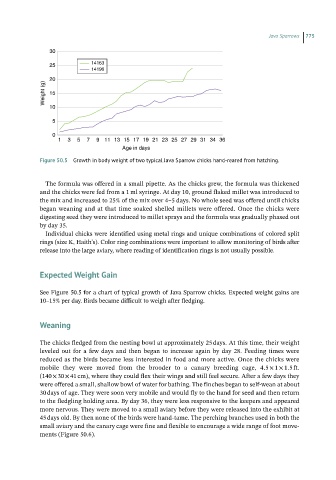Page 772 - Hand rearing birds second
P. 772
Java Sparrows 775
30
25 14163
14196
20
Weight (g) 15
10
5
0
1 3 5 7 911131517 19 21 23 25 27 29 31 34 36
Age in days
Figure 50.5 Growth in body weight of two typical Java Sparrow chicks hand-reared from hatching.
The formula was offered in a small pipette. As the chicks grew, the formula was thickened
and the chicks were fed from a 1 ml syringe. At day 10, ground flaked millet was introduced to
the mix and increased to 25% of the mix over 4–5 days. No whole seed was offered until chicks
began weaning and at that time soaked shelled millets were offered. Once the chicks were
digesting seed they were introduced to millet sprays and the formula was gradually phased out
by day 35.
Individual chicks were identified using metal rings and unique combinations of colored split
rings (size K, Haith’s). Color ring combinations were important to allow monitoring of birds after
release into the large aviary, where reading of identification rings is not usually possible.
ExpectedWeightGain
See Figure 50.5 for a chart of typical growth of Java Sparrow chicks. Expected weight gains are
10–15% per day. Birds became difficult to weigh after fledging.
Weaning
The chicks fledged from the nesting bowl at approximately 25 days. At this time, their weight
leveled out for a few days and then began to increase again by day 28. Feeding times were
reduced as the birds became less interested in food and more active. Once the chicks were
mobile they were moved from the brooder to a canary breeding cage, 4.5 × 1 × 1.5 ft.
(140 × 30 × 41 cm), where they could flex their wings and still feel secure. After a few days they
were offered a small, shallow bowl of water for bathing. The finches began to self‐wean at about
30 days of age. They were soon very mobile and would fly to the hand for seed and then return
to the fledgling holding area. By day 36, they were less responsive to the keepers and appeared
more nervous. They were moved to a small aviary before they were released into the exhibit at
45 days old. By then none of the birds were hand‐tame. The perching branches used in both the
small aviary and the canary cage were fine and flexible to encourage a wide range of foot move -
ments (Figure 50.6).

